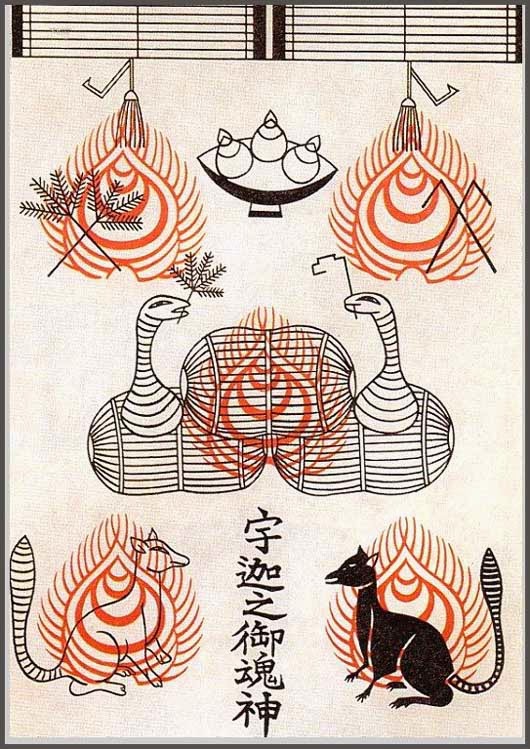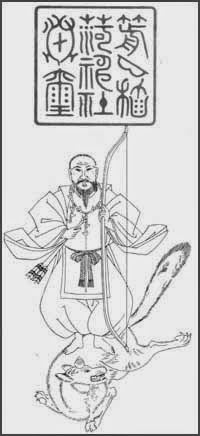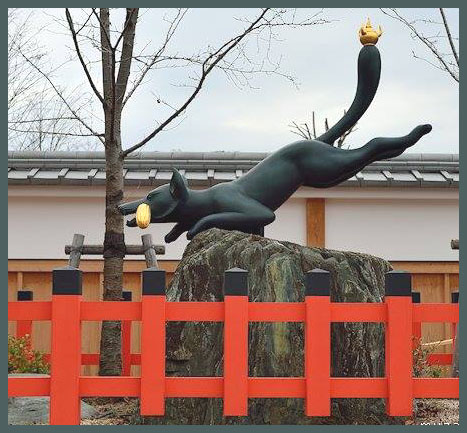. kitsune densetsu 狐 伝説 fox legends .
. Inari Fox Deity - on facebook .
. Inari 稲荷と伝説 Legends about the Fox Deity .
:::::::::::::::::::::::::::::::::::::::::::::::::::::::::::::::::::::::::::::::::::::::::::::::::::::::::::::::::::::::::::::::::::::::::::::::::::::::::::::::::::::::::::
| Inari 稲荷 the Fox Deity O-Inari sama お稲荷様 O-Kitsune sama お狐さま Honorable Fox / kitsune san キツネさん This is one of the most important deities of Japan. The deity of rice and a major Shinto kami. Closely associated with various Shinto deities of food, Inari can be depicted in either male or female form. Inari not only protects the rice harvest -- s/he is also the patron of prosperity for farmers and merchants, especially those involved in rice production, foodstuffs and fisheries. . INARI . Mark Schumacher Please read the details from Mark and come back here. . . . . . This traditional Japanese festival occurs on the first day of the horse according to the Asian lunar calendar. The horse is the messenger of the Inari Deity. . Fox Shrine Festival (Inari Matsuri 稲荷祭) . at the great shrine Fushimi Inari Taisha in Kyoto - 伏見稲荷大社 京都  Click for more photos of the shrine.  oefuda, o-e fuda 御絵札 "honorable picture amulet" This is a "secret fuda amulet" お札 of Fushimi Inari. It shows pine tree branches, ritual jewels, crossed keys, two foxes, black and white, and two snakes. Amulet against all kinds of disaster 災難除. sold for 1000 yen. 杉、玉、鍵、狐、蛇が描かれた伏見稲荷大社御絵札です。 伏見稲荷は全国のお稲荷さんの総元締めであり、このお札も秘伝の神符なので、霊験あらたかなんだと思います。 source : pws.prserv.net/hosaka - quote - The talisman from Fushimi Inari Taisha (probably dating from the Edo era) shows a bamboo curtain at top (non-anthropromorphic representation of Inari), five red-colored wish-granting jewels, three jewels in a bowl at top center, cedar boughs and sickles (験= しるしの杉, omens of luck), two snakes in rice bales (one with a ceder twig in its mouth and another with the key to the storehouse 倉の鍵 in its mouth, both symbols of wealth), and a white and black fox at the bottom with the name Uga no Mitama written in the middle. source : Mark Schumacher - quote "oefuda" It is designated as sainanyoke (災難除), or warding off of calamity. The image itself has been the subject of much scholarly study in Japan. After reading some Japanese academics texts and discussing with scholars in Japan, may I present some information about the present scholarly understanding of these symbols . . . ... The drawing is hierarchal in nature, with three levels... The bottom level shows two kitsune/myōbu (fox spirits/intercessors of Inari Ōkami). On the left is a white kitsune (白狐, modern Japanese: Shirokitsune; ancient Japanese and norito: Byakkō). The inner shrine of Fushimi Inari Taisha, Byakkōsha, is dedicated to a white kitsune such as this one. (the "inner shrine" is not the main shrine as the wording implies... it is simply further up the mountain from the main shrine). On the right is the black kitsune (黒狐, kurokitsune). The contrasting colors portray duality, an extremely strong element of Inari shinkō which we will visit another time. Overlaid in red atop both kitsune are nyoi hōju (Inari's wish-fulfilling jewel), marking Inari-sama's providence over the kitsune as Inari's shishi (divine animals of a kami). The middle level shows snakes, one with a branch of sugi (Japanese cedar) in its mouth, and the other with a key (kagi) in its mouth. Sugi are the sacred tree of Inari. The key is a deep symbol in Inari shinkō... the outer meaning is that it is the key to the rice granary -- the inner meaning merits later discussion. As for the snakes themselves, they are not shishi or animal familiars of Inari. In fact, the snake was the original symbol of Uka-no-Mitama-no-Ōkami -- or even, possibly, the original kami, dating back to prehistoric snake worship. Gradually, over time, the conception of Uka-no-Mitama-no-Ōkami's symbol (or even the kami itself) evolved from that of a snake, to that of the spirit that dwells within the rice -- the source of life itself. And thus, from the middle row, this evolution brings us to the top row... The top row shows more sugi branches on the left, and what is believed to be more keys on the right (this requires confirmation). At the top center are three jewels that can be understood to variously represent: --the spirit of rice, Inadama --the three peaks of Inari-yama, also strongly associated with the three original kami of Inari worship, Uka-no-Mitama-no-Ōkami, Satahiko-no-ōkami (Sarutahiko Ōkami), and Ōmiya-no-Me-no-Ōkami (Ame no Uzume no Mikoto). --Nyoi Hōju - source : Gary Cox - facebook Inari Faith International · 稲荷信仰国際協会  . Enmusubi and happy couples 縁結び . INARI refers to the Fox as the divine messenger and thus a deity himself. KITSUNE refers to the fox as an animal.  - source : kojiki.imawamukashi.com Yakyuu Inari Jinja 箭弓(やきゅう)稲荷神社 "Bow and Arrow Inari Shrine" Saitama 埼玉県東松山市 - 2 Chome-5-14 Yakyucho, Higashimatsuyama, Saitama Ukanomikami, Uka no Mikami 宇迦之御魂神 with bow and arrow This temple was founded in 712. The legend of bow and arrow goes back to Taira no Tadatsune 平忠常 (967 - 1031), Lord of Kazusa (now Chiba). also Governor of Shimōsa and Vice-Governor of Kazusa Provinces, and manager of the Grand Shrine of Ise in fact if not in name. In 1028, Tadatsune resigned from the office of Vice-Governor of Kazusa, and attacked Kazusa and Awa Provinces, seeking to expand his power base. The Imperial Court sought to stop him, and nominated Minamoto no Yorinobu, Governor of Ise Province, to lead the attack; he refused. The Court then appointed Taira no Naokata and Nakahara Narimichi, who were recalled soon afterwards, after making no progress. The Governor of Awa Province fled to Kyoto in 1030, and the following year, Minamoto no Yorinobu rose to the occasion, after being appointed Governor of Kai Province. Knowing he could not defeat Yorinobu, Tadatsune surrendered without a fight, and was taken prisoner, perishing on the way to the capital. - - - More in the WIKIPEDIA ! Yakyu Inari 野久稲荷 - 箭弓稲荷神社 社記によると、平安時代の中頃、下総の国(千葉県と茨城県の一部)の城主平忠常が謀反を起こし、またたく間に近隣諸国を切り従へ、ついにその威を関八州にふるい、大群をもって武蔵の国(埼玉県と東京都・神奈川県の一部)川越まで押し寄せてきました。 朝廷は、武門の誉れ高き武将源頼信を忠常追討の任に当たらせ、当地野久ヶ原に本陣を張り、頼信が野久稲荷神社に夜を徹して戦勝祈願をしたところ、明け行く空に箭(矢)の形をした白雲がにわかに現れ、その箭は敵を射るかのように飛んで行きました。 頼信は、これぞ神のご加護と奮いたち、自ら先頭に立ち敵陣に攻め入ると、ふいを突かれた忠常軍はあわてふためき、一旦は後退したもののすぐに盛り返し、三日三晩にわたる激戦も、神を信じ戦う頼信軍が勝利しました。 帰陣した頼信は、ただちに野久稲荷に戦勝報告を済ませると、この勝利はご神威、ご神徳によるものだとして、ご社殿の建て替えを寄進するとともに、野久稲荷を箭弓稲荷と改めて呼ぶようにと里人に命じたのでした。 以来、箭弓稲荷神社は松山城主、川越城主をはじめとして多くの人達等の信仰を集めてきましたが、平和な時代を迎へるとともに、前にも増して隆盛を極め、特に江戸時代には、江戸(東京都)をはじめ、四方遠近からの参拝者で社前市をなしたといわれています。 - Homepage of the shrine - source : www.yakyu-inari.jp . Kitsune Daruma 狐だるま 狐達磨 . . Myoobu Kitsune 命婦狐 Myobu Heian court ladies and foxes . ..............................................................................................................................................  Click for more photos ! komagitsune, koma no kitsune 狛狐 guardian foxes . koma 狛 guardian animals . ::::::::::::::::::::::::::::::::::::::::::::::::::::::::::::::::::::::::::::::::::::::::::::::::::::::::::::::::::::::::::::::::::::::::::::::::::::::::::::::::::::::::::: Inari ema 稲荷絵馬 votive tablets  from Fushimi Inari Shrine, Kyoto . . . CLICK here for EMA Photos ! :::::::::::::::::::::::::::::::::::::::::::::::::::::::::::::::::::::::::::::::::::::::::::::::::::::::::::::::::::::::::::::::::::::::::::::::::::::::::::::::::::::::::::::::::::::::::::::::::::::::::::::: Inari dorei 稲荷土鈴 clay bells  from Fushimi Inari Shrine, Kyoto . . . CLICK here for clay bell Photos ! . Dolls from Kasamori Inari Shrine Shizuoka ::::::::::::::::::::::::::::::::::::::::::::::::::::::::::::::::::::::::::::::::::::::::::::::::::::::::::::::::::::::::::::::::::::::::::::::::::::::::::::::::::::::::::: Kyoto . Sotan gitsune at temple Shokoku-Ji . 宗旦狐を拝みに相国寺 Tea Master Sen Sotan 千宗旦 (1578 - 1658) and the Kitsune Sotan Inari Jinja 宗旦稲荷神社 ................................................................................. . . . . . Fushimi Clay Dolls from Kyoto  uma nori kitsune 馬乗り狐 inari fox riding a horse The horse as the messenger of the fox-deity is used by the god from the Inari Fox Mountain (Inariyama 稲荷山) to inspect the mountains and fields.   senryobako mochi kitsune 千両箱持ち狐 fox carrying a money box  kuchi-ire kitsune 口入れ狐 employment agent (the one in the middle) more see below ....................................................................... hooju daki kitsune 宝珠抱き狐 fox embracing a wishfulfilling jewel   古型今戸人形 Old Imado Figure - - - - - A store introducing all kinds of Inari figures 狐面堂 Komen-Do  - reference source : www.komendou.com... - ....................................................................... goheimochi kitsune 御幣持ち狐 fox with a ritual wand foto to be found taiko nori kitsune 太鼓乗り狐 fox on a drum . . . CLICK here for Photos ! tawara nori kitsune 俵乗り狐(菱屋) fox on a straw bundle . . . CLICK here for Photos ! . . . . .  koogoo 香合 incence container This is the monk (or the fox who pretended to be a priest) Hakuzosu (白蔵主 / 伯蔵主 Hakuzoosu), who lived in Osaka at the temple Shorinji 小林寺耕雲庵. He was a believer in Inari sama and kept a few foxes in his temple. He used these foxes to fortell the future and this in turn became a comic story of Kyogen, Tsurigitsune 釣狐 The Fox catching fish. "The Fox and the Trapper" . . . CLICK here for "tsurigitsune" Photos ! Hakuzosu is also the subject of other pieces of art, like netsuke. . . . CLICK here for 白蔵主 Photos ! source : kyoudogangu.  Fox Dancing before a Fox Trap in the Kyôgen Play Tsurigitsune 歌川広重 Utagawa Hiroshige, . Kyogen Tsurigitsune 釣狐 . .................................................................................................................................................................. . Shusse Inari 出世稲荷神社 for a good career . ::::::::::::::::::::::::::::::::::::::::::::::::::::::::::::::::::::::::::::::::::::::::::::::::::::::::::::::::::::::::::::::::::::::::::::::::::::::::::::::::::::::::::: Saga  Inarigoma, Inari koma 稲荷駒 horse from the fox shrine a clay doll from Nogomi. Yuutoku Inari 祐徳稲荷 one of the three great Inari shrines of Japan Saga,Kashima 祐徳稲荷神社 Yutoku Inari Shrine is located in Kashima City, Saga Pref. It was set up by Hizen-Kashima Province in 1687. It enshrines Ugano-Mitama-no-Ohkami (the guardian deity of fishing, trade, and manufacture), Ohmiyame-no-Ohkami, and Sarutahiko-no-Ohkami. It is one of the three large Inari Shrines along with Fushimi Inari Shrine in Kyoto and Kasama Inari Shrine in Ibaragi Pref. The main hall is all colorfully lacquered structure in butai-zukuri style (with vast veranda supported by hundreds of pillars). Its base color is vermilion. The magnificent structure reminds us of Kiyomizu Temple in Kyoto. The shrine is called endearingly “Yutoku-san” by the local people and visited by a lot of worshippers all through the year. In the precinct of the shrine is Yutoku Museum, where historical materials concerning Kashima Province and treasures possessed by the shrine are displayed. source : nippon-kichi.jp :::::::::::::::::::::::::::::::::::::::::::::::::::::::::::::::::::::::::::::::::::::::::::::::::::::::::::::::::::::::::::::::::::::::::::::::::::::::::::::::::::::::::::::::::::::::::::::::::::::::::::::: Saitama . Sumo Inari 相撲稲荷 Kawagoe Hachimangu . a fox performing wrestling ::::::::::::::::::::::::::::::::::::::::::::::::::::::::::::::::::::::::::::::::::::::::::::::::::::::::::::::::::::::::::::::::::::::::::::::::::::::::::::::::::::::::::: - - - - - Tokyo / Edo - - - - - In Edo there were Inari fox shrines at every corner. . Chanoki Inari 茶の木稲荷 / 茶ノ木稲荷神社 Inari and the Tea Tree . Hikan jinja shrine 被官稲荷社 and Hanasono Inari jinja 花園稲荷神社 both are near the famous Kannon temple in Asakusa.  teppoo kitsune 鉄砲狐 "cannon fox" The name derives from their form, they look like cannonballs. shinko 神狐 fox deity It was customary to place a pair of these foxes at the entrance of an Inari Shrine. Since they always come in a pair, this signifies a shrine where people pray for a good partner (enmusubi). They are most popular at the Hanasono Inari jinja 花園稲荷神社 ................................................................................. . Chiyoda ward 千代田区 . Morikawa Inari 森川稲荷, 三光院いなり Sanko-In Inari, 腰掛稲荷 Koshikake Inari On the 11th day of the second lunar month in 1827, on the night before the festival of the First Day of the Horse, the low-ranking Samurai 幸吉 Kokichi from 新道一番町 Shindo Ichibancho told his master that he was off to the Morikawa Inari shrine, where he lived. Next morning his master found a wooden statue of Inari at his doorstep. From this day on, if he had a wish to make to Inari, he would ask Kokichi to mediate for him. On the first day of the third lunar month, his master and 若殿 the young lord made an offering of ritual Sake for the Deity. Looking closer the next day, half of the Sake and the other food offerings were gone. So they thought the Inari deities from Sanko-In and the Koshikake Inari had come too. Sanko-In Inari, present day 花園神社 Hanazono Jinja 5 Chome-17-3 Shinjuku ward Koshikake Inari Shrine 腰掛稲荷神社 3 Chome-26-1 Mejirodai, Bunkyō ward  ................................................................................. Kuchi-ire Inari shrine 口入稲荷神社 口入稲荷大神 kuchi-ireya was an important employment agency name in Edo and these shrined were frequented by the many patrons of the business. People bought a set of these three deities and prayed to them in a small Inari shrine in their garden. When their wish was granted, they brought them back to the main shrine in gratitude. Sometimes the three foxes represented the head cleark of the agency, a groom and the bride. kuchi-ire literally means "to add a mouth" and could be a new employee or a bride (one more mouth to feed in the household). You could only find employment if some agent vouched for your person. This shrine was located in the garden of the former employment agent Takadaya 高田屋 in the Yoshiwara pleasure quarters of Edo.  o-kitsune sama お狐さま "honorable God Fox" haori kitsune 羽織狐 fox wearing haori coat amulet for good business . . . CLICK here for Photos !  kamishimo kitsune 裃狐 fox wearing formal robe amulet for finding a partner  裃(かみしも)きつね - source : 門司ヶ関人形工房 - ................................................................................. . Shoozoku Inari shrine, Shozoku 装束稲荷神社 "Shrine to change robes" . Ooji Inari Jinja 王子稲荷神社 Oji Inari Fox Shrine Ooji no kitsune 王子の狐 the fox from Oji 絵馬「狐火」 Kitsunebi "fox fire" Shibaraku kitsune 暫狐 the Shibaraku Kabuki Kitsune ::::::::::::::::::::::::::::::::::::::::::::::::::::::::::::::::::::::::::::::::::::::::::::::::::::::::::::::::::::::::::::::::::::::::::::::::::::::::::::::::::::::::::: Fukagawa Fudo Temple 深川不動堂 Tokyo . Gankake kitsune 願掛けきつね . :::::::::::::::::::::::::::::::::::::::::::::::::::::::::::::::::::::::::::::::::::::::::::::::::::::::::::::::::::::::::::::::::::::::::::::::::::::::::::::::::::::::::::  . . . CLICK here for Photos ! . Reference . :::::::::::::::::::::::::::::::::::::::::::::::::::::::::::::::::::::::::::::::::::::::::::::::::::::::::::::::::::::::::::::::::::::::::::::::::::::::::::::::::::::::::::  source : Hayato on facebook - quote By every shady wayside and in every ancient grove; on almost every hilltop and in the outskirts of every village, you may see, while traveling through the Honshū countryside, some little Shintō shrine, in front of which, or at either side of which, are images of seated foxes of stone. Usually there is a pair of these, facing each other. There may be a dozen, or a score, or several hundred; in which case, most of the images are very small. In more than one of the larger towns you may see in the courtyard of some great miya, a countless host of stone foxes; of all dimensions, from toy figures only a few inches high to giants, whose pedestals tower over your head, all squatting around the temple in tiered ranks of thousands. Everybody knows that such shrines and temples are dedicated to Inari, the God of Rice. After having traveled much in Japan, you will find that whenever you try to recall any country place you have visited, there will appear in some nook or corner of the memory, a pair of green and gray foxes of stone: with broken noses. In my memories of Japanese travel, these shapes have become convention, as picturesque detail. - Lafcadio Hearn in "Glimpses of Unfamiliar Japan, Volume I. :::::::::::::::::::::::::::::::::::::::::::::::::::::::::::::::::::::::::::::::::::::::::::::::::::::::::::::::::::::::::::::::::::::::::::::::::::::::::::::::::::::::::::  source : facebook Hoshi no Tama 星の玉 The Fox and the Jewel Karen Ann Smyers This book describes the rich complexity of Inari worship in contemporary Japan. It explores questions of institutional and popular power in religion, demonstrates the ways people make religious figures personally meaningful, and documents the kinds of communicative styles that preserve the appearance of homogeneity in the face of astonishing factionalism.  source : books google A collection of old Ema and Paintings about the Rice Culture of Japan 稲作の四季(四季農耕図全体) 第2章 みんなで社寺詣 source : www.ruralnet.or.jp . Welcome to Edo 江戸 ! .  source : keiko on facebook kodaki kitsune 子抱き狐 fox and her child Toyokawa Inari :::::::::::::::::::::::::::::::::::::::::::::::::::::::::::::::::::::::::::::::::::::::::::::::::::::::::::::::::::::::::::::::::::::::::::::::::::::::::::::::::::::::::::  やっくん きゅうちゃんと縁結びの木 Yak-kun and Kyu-chan Yakyu Inari Jinja 箭弓稲荷神社 埼玉県東松山市 Saitama, Matsuyama city |
:::::::::::::::::::::::::::::::::::::::::::::::::::::::::::::::::::::::::::::::::::::::::::::::::::::::::::::::::::::::::::::::::::::::::::::::::::::::::::::::::::::::::::

. Inari Fox Deity - on facebook .
:::::::::::::::::::::::::::::::::::::::::::::::::::::::::::::::::::::::::::::::::::::::::::::::::::::::::::::::::::::::::::::::::::::::::::::::::::::::::::::::::::::::::::

. WKD - Fox Shrine Festivals and Kigo .
- #inarikitsune #inarifox #kitsune -
:::::::::::::::::::::::::::::::::::::::::::::::::::::::::::::::::::::::::::::::::::::::::::::::::::::::::::::::::::::::::::::::::::::::::::::::::::::::::::::::::::::::::::
. Inari 稲荷と伝説 Legends about the Fox Deity .
. Inarizushi / Inari Sushi いなりずし . 稲荷寿司 .
Kitsune Jinja きつね神社
. Japan - Shrines and Temples .
. Regional Folk Toys from Japan .
. Tohoku after the BIG earthquake March 11, 2011
[ . BACK to WORLDKIGO . TOP . ]
[ . BACK to DARUMA MUSEUM TOP . ]
:::::::::::::::::::::::::::::::::::::::::::::::::::::::::::::::::::::::::::::::::::::::::::::::::::::::::::::::::::::::::::::::::::::::::::::::::::::::::::::::::::::::::::
8 comments:
Dennis Chibi wrote
fox shrine...
everywhere a chance
to pray!
.
facebook
Yosa Buson in Kyoto
春の夜や 狐の誘ふ上童
haru no yo ya kitsune no izanau ue warawa
spring night -
a fox comes to lure
a lady servant
uewarawa were young maidens serving at the royal palace.
usu Inari 臼稲荷 sanctuary of Inari with mortars
石臼を抱えて持ち上げてしまったモミジの古木
at
Gaya-In 伽耶院(がやいん)temple Gaya In of the Tendai sect
兵庫県三木市志染町大谷 - Hyogo, Miki town
.
Foxtrot's Guide to Kitsune Lore
very extensive database
.
http://www.cyberus.ca/~foxtrot/kitsune/
.
Kobayashi Issa
霰こんこんこん触ル狐哉
arare kon kon kon fureru kitsune kana
hailstones!
a fox screams out
big news
This winter hokku is from the second lunar month (March) of 1818, when Issa was traveling around near his hometown visiting students and friends. Issa doesn't seem to be taking the fox's loud yelps as expressions of pain from being hit by hailstones. Instead, he seems impressed by the way the fox cries out (in a way that resembles human screams) to its fellow foxes to alert them to the danger of the hailstorm, which has just begun. For foxes and many other creatures, a hailstorm is a momentous event, and presumably the fox is warning his/her fellows that they need to stay in their lairs.
The kon-kon-kon expands and plays on at least three meanings of kon-kon: 1. a semi-onomatopoetic adverb used to suggest rain, hail, or snow falling plentifully and steadily, 2. a similar expression used to suggest the sound of human coughing or the throaty yelps of foxes, and 3. a triply repeated verbal form (来ん) that means "It's begun!" or "It's here!" and suggests the fox cries out continuously. The transitive verb fureru in the second line means to tell publicly, inform widely, spread news or information, proclaim, make a pronouncement. (See Issa's Collected Works 3.516 and Maruyama Kazuhiko, ed., Issa shichiban nikki 2.379.)
Chris Drake
Takayama Inari Jinja 高山稲荷神社 Takayama Inari Shrine, Aomori
小神祠公園
Old small shrines from all over Tohoku are "retired" here in a special park.
.
https://japanshrinestemples.blogspot.jp/2017/07/takayama-inari-tsugaru.html
.
Legends
kori 狐狸と伝説 Legends about fox and Tanuki badger
kori yookai 狐狸妖怪 fox and Tanuki yokai monsters
https://heianperiodjapan.blogspot.com/2018/06/kori-fox-and-badger-legends.html
.
やっくん きゅうちゃんと縁結びの木 Yak-kun and Kyu-chan
Yakyu Inari Jinja 箭弓稲荷神社
埼玉県東松山市 Saitama, Matsuyama city
.
Post a Comment